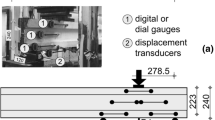Abstract
The results of a non-linear analysis model of reinforced concrete beams using a high-performance fibre-reinforced cement (FRC) based matrix are described and compared with experimental observations. The constitutive relationship of the FRC materials used in both compression and tension and the logical flow chart for the non-linear analysis model are described. Analytical predictions of moment versus curvature and moment versus deflection curves are compared with experimentally observed results of reinforced concrete beams using a SIFCON (slurry infiltrated fibre concrete) matrix. The use of a fibre-reinforced matrix in the compression zone of a reinforced concrete beam allows for other over-reinforced sections to achieve significant increases in structureal ductility while resisting loads close to their ultimate load. Ductility and energy ratios, normalized by the control beam without fibres, ranged from 2.47 to 3.60 and 3.28 to 5.69, respectively; that is several hundred per cent in improvement. The analytical model is shown to predict, with reasonably good agreement, experimental observations of moment-curvature and moment-deflection curves. Thus it can be used to evaluate the effects of various parameters in order to optimize structural performance.
Resume
On décrit les résultats d’analyse non linéaire de poutres de béton armé utilisant une matrice de haute performance à base de composites de ciment-fibres (CCF), et on les compare aux résultats expérimentaux. On décrit les relations constitutives des matériaux CCF utilisés aussi bien en compression qu’en traction, ainsi que le diagramme d’écoulement logique pour le modèle d’analyse non linéaire. On compare les prédictions analytiques moment-courbure et moment-flèche aux résultats expérimentaux observés sur des poutres de béton armé utilisant une matrix SIFCON (slurry-infiltrated fibre concrete).
L’utilisation d’une matrice renforcée de fibres dans des zones de compression d’une poutre en béton armé permet à des sections qui, sinon, seraient surchargées en armature, d’atteindre des améliorations appréciables de ductilité structurelle quand elles sont soumises à des charges proches de la charge de rupture. Les pourcentages de ductilité et d’énergie, normalisés par la poutre de contrôle dépourvue de fibres, se situaient respectivement entre 2,47 et 3,60, et 3,28 et 5,69, soit plusieurs centaines de pourcents d’amélioration. On constate que le modèle analytique prédit, avec une concordance assez satisfaisante, les observations expérimentales moment-courbure et moment-flèche. Il peut donc être utilisé pour évaluer les effets de différents paramètres afin d’optimiser la performance structurelle.
Similar content being viewed by others
References
Reinhardt, H. W. and Naaman, A. E. (eds), ‘High Performance Fiber Reinforced Cement Composites’ (Spon, London, 1992).
Naaman, A. E., Harajli, M. H. and Wight, J. K., ‘Analysis of ductility in partially prestressed concrete flexural members’,PCI J. 31 (3) (1986) 64–87.
Park, R. and Thompson, K. J. ‘Ductility of prestressed and partially prestressed concrete sections’,-ibid. 25 (2) (1980) 45–69.
Homrich, J. and Naaman, A. E., ‘Stress-strain properties of SIFCON in compression’, in ‘Fiber Reinforced Concrete Properties and Applications’, SP-105 (American Concrete Institute, Detroit, Michigan, 1987).
Naaman, A. E. and Homrich, J. R., “Tensile stress-strain properties of SIFCON’,ACI Mater. J. 86 (3) (1989) 244–251.
Shah, S. P., Fafitis, A. and Arnold, R., ‘Cyclic loading of spirally reinforced concrete’,J. Struct. Div. ASCE 109 (7) (1982) 1695–1710.
ACI Building Code Requirements for Reinforced Concrete, Committee 318 (American Concrete Institute, Detroit, 1989).
Absi, E. and Naaman, A. E., ‘Modèle rhéologique pour les bétons de fibres’, in Proceedings of 3rd International Symposium on Fiber Reinforced Cement and Concrete, Sheffield, UK, July 1986, edited by R. N. Swamy, R. L. Wagstaffe and D. R. Oakley.
Reinhardt, H. W. and Fritz, C., ‘SIFCON—Production and Characteristic Mechanical Properties’ (in German) (Report No. DFG Re. 691/1-1/2 (Institut für Massivbau, TH, Darmstadt, 1989).
Kosa, K. and Naaman, A. E., ‘Corrosion of steel fiber reinforced concrete’,ACI Mater. J. 87 (1) (1990) 27–37.
Sargin, M., ‘Stress-strain relationships for concrete and the analysis of structural concrete sections’, Study No. 4 Solid Mechanics Division (University of Waterloo, Ontario, Canada, 1971).
Corley, W. G., ‘Rotational capacity of reinforced concrete beams’,ASCE J. Struct. Div. 92 (ST5) (1966) 121–146.
Mattock,-ibid. 93(4) (1967).
Naaman, A. E., Reinhardt, H. W. and Fritz, C., ‘Reinforced concrete beams with a SIFCON matrix’,ACI Mater. J. 89 (1) (1992) 79–88.
—Idem.,, ‘Reinforced concrete beams using SIFCON as a matrix’, Darmstader Massivbau Report Band 1 (Technische Hochschule, Darmstadt, Germany, 1990).
Author information
Authors and Affiliations
Rights and permissions
About this article
Cite this article
Naaman, A.E., Reinhardt, H.W., Fritz, C. et al. Non-linear analysis of RC beams using a SIFCON matrix. Materials and Structures 26, 522–531 (1993). https://doi.org/10.1007/BF02472863
Issue Date:
DOI: https://doi.org/10.1007/BF02472863



